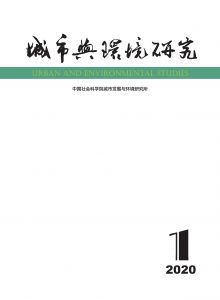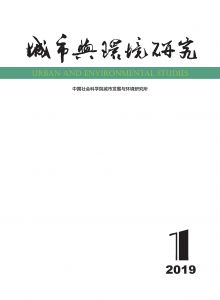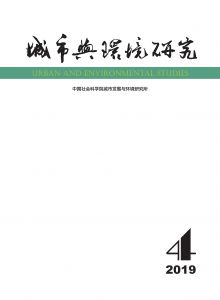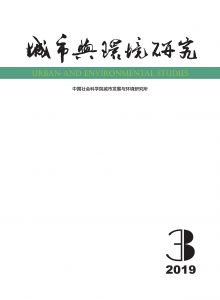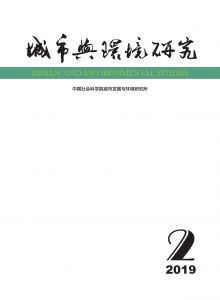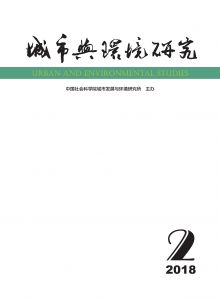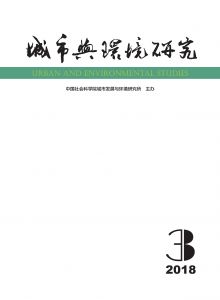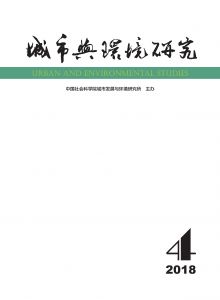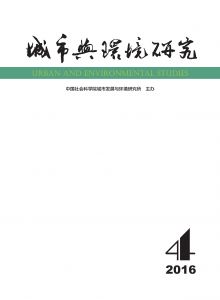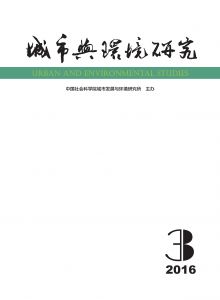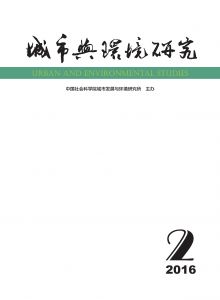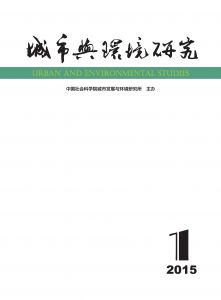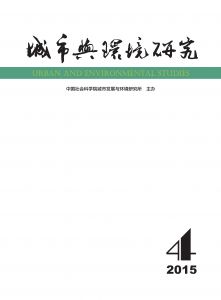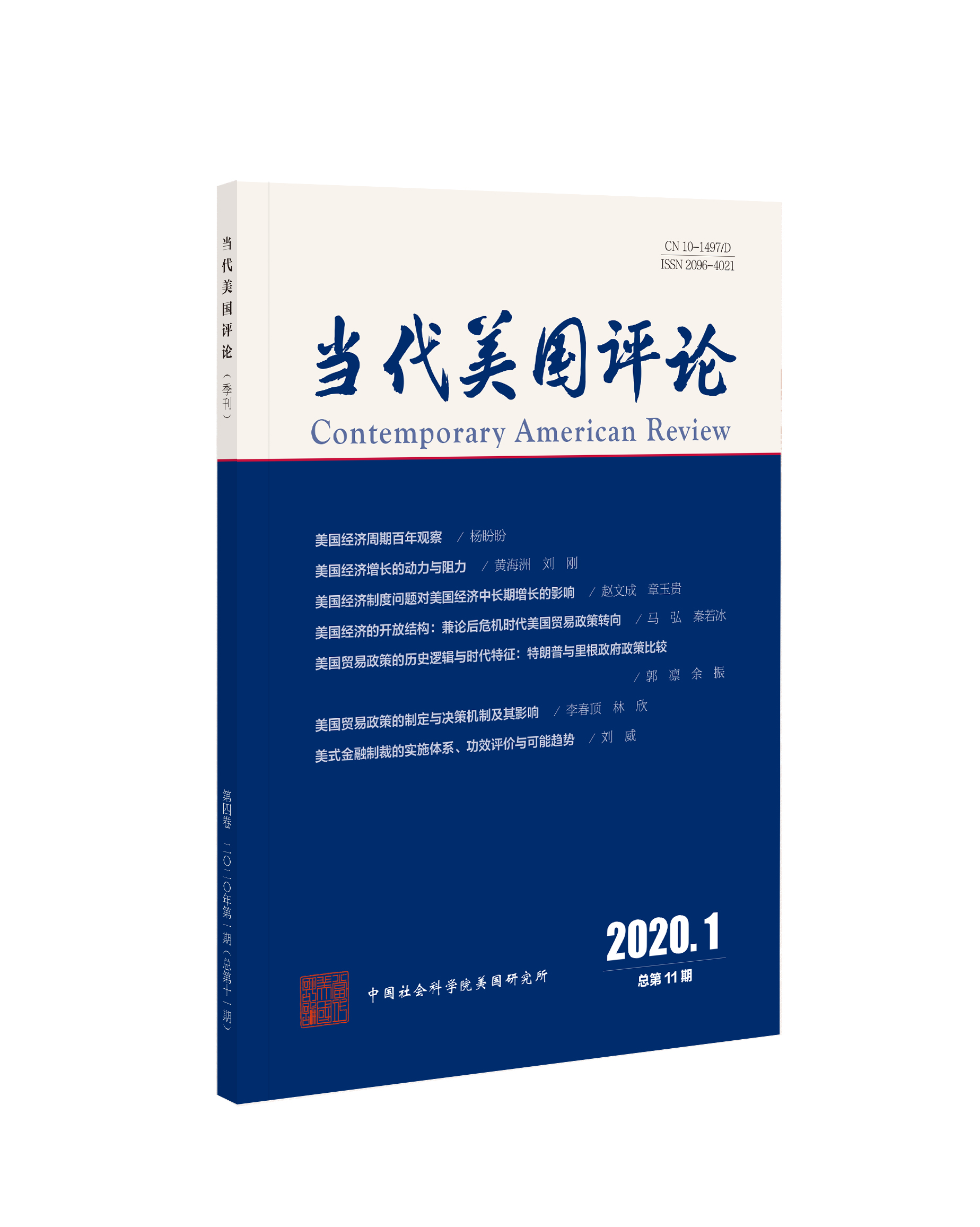最新期刊
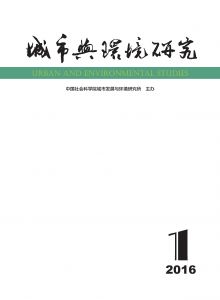
目录
过往期刊
参考文献
-
编委会
-
·学术论文·
-
京津冀地区间经济影响及溢出和反馈效应分析
-
上海大型居住社区的特征、问题与未来发展
-
中国城市科技创新网络结构特点研究
-
北京市科技型中小企业的空间集聚特征与影响因素
-
人口年龄结构转变对经济增长的影响研究
-
中国人口迁移的变化趋势及空间格局
-
-
·学术综述·
-
人口老龄化与社会经济发展相互关系研究进展
-
-
投稿须知
-
版权页
按年份浏览:
- 全部
- 2020
- 2019
- 2018
- 2017
- 2016
- 2015
- 2014
[1][1]潘文卿、李子奈(2007):《中国沿海与内陆间经济影响的反馈与溢出效应》,《经济研究》第5期,第68~77页。
[2][2]吴福象、朱蕾(2010):《中国三大地带间的产业关联及其溢出和反馈效应——基于多区域投入产出分析技术的实证研究》,《南开经济研究》第5期,第140~152页。
[3][3]张亚雄、赵坤(2005):《区域间投入产出分析》,北京:社会科学文献出版社。
[4][4]Dietzenbacher,E.(2002),“Interregional Multipliers:Look Backward,Looking Forward”,Regional Studies ,36(2),pp.125-136.
[5][5]Miller,R.E.(1963),“Comments on the ‘General Equilibrium’ Model of Professor Moses”,Metroeconomica ,15(2-3),pp.82-88.
[6][6]Sonis,M. and G.J.D.Hewings(1999),“Miyazawa’s Contributions to Understanding Economic Structure:Interpretation,Evaluation and Extensions”,in Hewings G.J.D.,M.Sonis,and M.Madden,et al.(eds.),Understanding and Interpreting Economic Structure:Essays in Honour of Kenichi Miyazawa ,Heidelberg:Springer-Verlag,pp.13-51.
[7][7]Van Der Linden J.A. and J.Oosterhaven(1995),“European Community Intercountry Input-Output Relations:Construction Method and Main Results for 1965-1985”,Economic Systems Research ,7(3),pp.249-269.
[8][8]范志海、刘钢、李高业(2010):《大型居住社区治理模式初探——以上海三林世博家园社区为例》,《华东理工大学学报(社会科学版)》第5期,第1~6页。
[9][9]方舒(2015):《保障房社区治理路径新探——以北京C社区的治理实践为例》,《甘肃社会科学》第1期,第11~15页。
[10][10]方园(2013):《打造保障性安居工程——本市推进保障性住房大型居住社区建设纪略》,《上海人大(月刊)》第8期,第16~17页。
[11][11]黄怡、周俭(2011):《大型社区的人口、住房、活力与公平:上海大型社区规划理念与策略的社会学思考》,《时代建筑》第4期,第24~29页。
[12][12]伋晓光(2013):《新型城镇化背景下上海大型居住社区文化内涵的构建》,《上海文化》第10期,第21~27页。
[13][13]李梦玄、周义、胡培(2013):《保障房社区居民居住—就业空间失配福利损失研究》,《城市发展研究》第10期,第63~68页。
[14][14]李志刚、任艳敏、李丽(2014):《保障房社区居民的日常生活实践研究——以广州金沙洲社区为例》,《建筑学报》第2期,第12~16页。
[15][15]马倩、张龄、俞秉懿(2012):《转型背景下大型居住社区复合生活网络初探——以浦东铁路惠南站大型居住社区规划为例》,《上海城市规划》第1期,第55~60页。
[16][16]马士江、许俭俭(2012):《大都市郊区大型居住社区交通支撑优化和提升思考——以上海市松江南站大型居住社区为例》,中国城市规划年会论文,第50~62页。
[17][17]彭善民(2012):《新建大型居住社区管理的困境与创新》,《学术评论》第1期,第99~104页。
[18][18]孙姗珊、杨东援、陈川(2013):《外围大型居住社区居民出行特征分析》,《上海城市规划》第5期,第100~104页。
[19][19]汪慧婷(2013):《“镇管社区”:快速城市化进程中的社区管理模式创新——以浦东航头镇大型居住社区为例》,华东政法大学硕士学位论文,第10~20页。
[20][20]王方兵、吴瑞君(2014):《大型保障房社区建设对区域人口发展的影响——以上海市为例》,《人口与社会》第1期,第27~31页。
[21][21]熊健(2011):《上海大型居住社区规划的实践和思考》,《上海城市规划》第3期,第36~40页。
[22][22]尹维娜、徐靓(2012):《从大型居住社区到新市镇——上海金山北站大型住区规划思考》,《城市规划学刊》第7期,第154~158页。
[23][23]贠栋(2014):《上海大型居住社区治理研究——以泗泾大型居住社区为例》,华东政法大学硕士学位论文,第1~20页。
[24][24]张萍、李素艳、黄国洋等(2013):《上海郊区大型社区居民使用公共设施的出行行为及规划对策》,《规划师》第5期,第91~95页。
[25][25]张翔(2013):《大型居住社区交通规划研究——以上海市嘉定黄渡大型居住社区交通规划为例》,《交通与运输》第5期,第4~6页。
[26][26]周俭、黄怡(2011):《营造城市大型居住社区的多样性》,《上海城市规划》第3期,第22~25页。
[27][27]周素红、程璐萍、吴志东(2010):《广州市保障性住房社区居民的居住——就业选择与空间匹配性》,《地理研究》第10期,第1735~1745页。
[28][28]朱锡金(2011):《对大型居住社区的概念认知和上海住宅建设发展的断想》,《上海城市规划》第3期,第3~6页。
[29][29]Brama,A.(2006),“‘White Flight’?The Production and Reproduction of Immigrant Concentration Areas in Swedish Cities,1990-2000”,Urban Studies ,43(7),pp.1127-1146.
[30][30]Marcuse,P.(1997),“The Enclave,the Citadel,and the Ghetto:What Has Changed in the Post-Fordist U.S.City”,Urban Affairs Review ,33(2),pp.228-264.
[31][31]Painter,G.,C.Y.Liu and D.Zhuang(2007),“Immigrants and the Spatial Mismatch Hypothesis:Employment Outcomes Among Immigrant Youth in Los Angeles”,Urban Studies ,44(13),pp.2627-2649.
[32][32]Veldhuisen,J.,H.Timmermans and L.Kapoen(2000),“RAMBLS:A Regional Model Based on the Microsimulation of Daily Activity Travel Patterns”,Environment and Planning A ,32(3),pp.427-443.
[33][33]Wacquant,L.J.D.(2008),Urban Outcasts:A Comparative Sociology of Advanced Marginality ,Cambridge,UK:Polity Press.
[34][34]Whitehead,C.M.E.(2007),“Planning Policies and Affordable Housing:England as a Successful Case Study?”,Housing Studies ,22(1),pp.25-44.
[35][35]鲍超、陈小杰(2014):《中国城市体系的空间格局研究评述与展望》,《地理科学进展》第10期,第1300~1311页。
[36][36]陈子凤、官建成(2009):《合作网络的小世界性对创新绩效的影响》,《中国管理科学》第3期,第115~120页。
[37][37]方创琳(2011):《中国城市群形成发育的新格局及新趋向》,《地理科学》第9期,第1025~1034页。
[38][38]金钟范(2010):《基于企业母子联系的中国跨国城市网络结构——以中韩城市之间联系为例》,《地理研究》第9期,第1670~1682页。
[39][39]乐平(2006):《用CSCD数据库作各学科定量评价工具有缺陷》,《科技情报开发与经济》第10期,第238~239页。
[40][40]刘军(2014):《整体网分析讲义:UCINET软件实用指南》,上海:格致出版社/上海人民出版社。
[41][41]刘娅(2011):《从国际科技合著论文状况看中国环境领域国际科技合作态势》,《中国软科学》第6期,第34~46页。
[42][42]吕国庆、曾刚、顾娜娜(2014):《经济地理学视角下区域创新网络的研究综述》,《经济地理》第2期,第1~8页。
[43][43]钱锡红、杨永福、徐万里(2010):《企业网络位置、吸收能力与创新绩效——一个交互效应模型》,《管理世界》第5期,第118~129页。
[44][44]吴素春、聂鸣(2013):《以创新型城市为主导的区域科研合作网络研究——以湖北省论文合著数据为例》,《情报杂志》第8期,第125~131页。
[45][45]武前波、宁越敏(2012):《中国城市空间网络分析——基于电子信息企业生产网络视角》,《地理研究》第2期,第207~219页。
[46][46]谢科范、张诗雨、刘骅(2009):《重点城市创新能力比较分析》,《管理世界》第1期,第176~177页。
[47][47]尹丽春、殷福亮、姜春林等(2007):《基于CSCD和SCI的跨省区科学合作网络可视化分析》,《图书情报工作》第8期,第62~65页。
[48][48]周一星、胡智勇(2002):《从航空运输看中国城市体系的空间网络结构》,《地理研究》第3期,第276~286页。
[49][49]朱强、戴龙基、蔡蓉华(2008):《中文核心期刊要目总览:2008年版》,北京:北京大学出版社。
[50][50]Alderson,A.S.,J.Beckfield and J.Sprague-Jones(2010),“Intercity Relations and Globalization:the Evolution of the Global Urban Hierarchy,1981-2007”,Urban Studies ,47(9),pp.1899-1923.
[51][51]Bruinsma,F. and P.Rietveld(1993),“Urban Agglomerations in European Infrastructure Networks”,Urban Studies ,30(6),pp.919-934.
[52][52]Cantner,U. and H.Graf(2006),“The Network of Innovators in Jena:An Application of Social Network Analysis”,Research Policy ,35(4),pp.463-480.
[53][53]Carroll,G.R.(1982),“National City-size Distributions:What Do We Know After 67 Years of Research?”,Progress in Human Geography ,6(1),pp.1-43.
[54][54]Cooke,P.(1996),“The New Wave of Regional Innovation Networks:Aanalysis,Characteristics and Strategy”,Small Business Economics ,8(2),pp.159-171.
[55][55]Cooke,P.,M.G.Uranga and G.Etxebarria(1998),“Regional Systems of Innovation:An Evolutionary Perspective”,Environment and Planning A ,30(9),pp.1563-1584.
[56][56]Derudder,B.(2006),“On Conceptual Confusion in Empirical Analyses of a Transnational Urban Network”,Urban Studies ,43(11),pp.2027-2046.
[57][57]Fleming,L.,III.C.King and A.I.Juda(2007),“Small Worlds and Regional Innovation”,Organization Science ,18(6),pp.938-954.
[58][58]Freeman,C.(1987),Technology Policy and Economic Performance:Lessons from Japan ,London:Pinter Publishers.
[59][59]Freeman,C.(1991),“Networks of Innovators:A Synthesis of Research Issues”,Research Policy ,20(5),pp.499-514.
[60][60]Glanzel,W.(2001),“National Characteristics in International Scientific Co-authorship Relations”,Scientometrics ,51(1),pp.69-115.
[61][61]Johnston,R.J.,D.Gregory and D.M.Smith(1994),The Dictionary of Human Geography ,Cambridge:Blackwell Publishers Inc.
[62][62]Martin,R. and J.Simmie(2008),“Path Dependence and Local Innovation Systems in City-regions,Innovation:Management”,Policy & Practice ,10(2-3),pp.183-196.
[63][63]Matthiessen,C.W.,A.W.Schwarz and S.Find(2010),“World Cities of Scientific Knowledge:Systems,Networks and Potential Dynamics”,Urban Studies ,47(9),pp.1879-1897.
[64][64]Newman,M.E.J.(2001a),“Scientific Collaboration Networks,II.Shortest Paths,Weighted Networks,and Centrality”,Physical Review E ,64(1)-016132,pp.1-7.
[65][65]Newman,M.E.J.(2001b),“The Structure of Scientific Collaboration Networks”,PNAS ,98(2),pp.404-409.
[66][66]OECD(2001),Innovative Networks:Cooperation in National Innovation Systems ,Paris:OECD.
[67][67]Russo,M. and F.Rossi(2009),“Cooperation Networks and Innovation:A Complex Systems Perspective to the Analysis and Evaluation of a Regional Innovation Policy Programme”,Evaluation ,15(1),pp.75-99.
[68][68]Simmie,J.,J.Sennett and P.Wood(2002),“Innovation in Europe:A Tale of Networks,Knowledge and Trade in Five Cities”,Regional Studies ,36(1),pp.47-64.
[69][69]Sun,S. and S.M.Manson(2011),“Social Network Analysis of the Academic GIScience Community”,The Professional Geographer ,63(1),pp.18-33.
[70][70]Taylor,P.J. and R.Aranya(2008),“A Global ‘Urban Roller Coaster’?Connectivity Changes in the World City Network,2000-2004”,Regional Studies ,42(1),pp.1-16.
[71][71]陈良文(2013):《美国支持科技型中小企业发展的经验及启示》,《经济纵横》第7期,第106~109页。
[72][72]段德忠、杜德斌、刘承良(2015):《上海和北京城市创新空间结构的时空演化模式》,《地理学报》第12期,第1911~1925页。
[73][73]高超、金凤君(2015):《沿海地区经济技术开发区空间格局演化及产业特征》,《地理学报》第2期,第202~213页。
[74][74]高松、庄晖、牛盼强(2011):《科技型中小企业政府资助效应提升研究——基于企业生命周期的观点》,《中国工业经济》第7期,第150~158页。
[75][75]李国平、孙铁山、卢明华(2003):《北京高科技产业集聚过程及其影响因素》,《地理学报》第6期,第927~936页。
[76][76]刘降斌、李艳梅(2008):《区域科技型中小企业自主创新金融支持体系研究——基于面板数据单位根和协整的分析》,《金融研究》第12期,第193~206页。
[77][77]卢明华、李丽(2012):《北京电子信息产业及其价值链空间分布特征研究》,《地理研究》第10期,第1861~1871页。
[78][78]马贱阳、曾建新、聂荣喜(2002):《加入WTO后科技型中小企业技术创新战略调整》,《经济地理》第3期,第266~268页。
[79][79]毛广雄、廖庆、刘传明等(2015):《高新技术产业集群化转移的空间路径及机理研究——以江苏省为例》,《经济地理》第12期,第105~112页。
[80][80]尚增健(2002):《渐进式技术创新:科技型中小企业的成长路径——成长型中小企业成长机理的个案分析》,《管理世界》第6期,第124~133页。
[81][81]唐根年、徐维祥(2004):《中国高技术产业成长的时空演变特征及其空间布局研究》,《经济地理》第5期,第604~608页。
[82][82]王缉慈、宋向辉、李光宇(1996):《北京中关村高新技术企业的集聚与扩散》,《地理学报》第6期,第481~488页。
[83][83]王缉慈、王敬甯、姜冀轩(2009):《深圳数字电视产业的地理集聚——研究高新技术创新集群的一个尝试》,《地理科学进展》第5期,第673~682页。
[84][84]王立军(2001):《科技型中小企业成长环境与对策研究——对浙江省一千余家科技型中小企业的调查报告》,《软科学》第3期,第28~31页。
[85][85]吴瑾(2012):《科技型中小企业技术创新基金政策变迁研究——基于政策网络的视角》,《科学学研究》第3期,第366~371页。
[86][86]张同斌、王千、刘敏(2013):《中国高新园区集聚的空间特征与形成机理》,《科研管理》第7期,第53~60页。
[87][87]章卫民、劳剑东、李湛(2008):《科技型中小企业成长阶段分析及划分标准》,《科学学与科学技术管理》第5期,第135~139页。
[88][88]赵驰、周勤(2011):《基于自组织视角的科技型中小企业成长研究》,《软科学》第10期,第94~100页。
[89][89]周国红、陆立军(2001):《科技型中小企业创新绩效的行为因素研究》,《数量经济技术经济研究》第9期,第84~87页。
[90][90]周国红、陆立军、孙家良(2003):《基于科技型中小企业群的区域经济竞争力研究》,《经济地理》第3期,第313~318页。
[91][91]Aghion,P. and P.Howitt(1992),“A Model of Growth Through Creative Destruction”,Econometrica ,60(2),pp.323-351.
[92][92]Buckley,P.J. and M.C.Casson(2009),“The Internalization Theory of the Multinational Enterprise:A Review of the Progress of a Research Agenda After 30 Years”,Journal of Int ernational Business Studies ,40(9),pp.1563-1580.
[93][93]Camagni,R.(1991),Innovation Networks:Spatial Perspectives ,London:Belhaven Press.
[94][94]Carter,R. and H.Auken(2006),“Small Firm Bankruptcy”,Journal of Small Business Management ,44(4),pp.493-512.
[95][95]Cooper,S.Y. and J.S.Park(2008),“The Impact of ‘Incubator’ Organization on Opportunity Recognition and Technology Innovation in New,Entrepreneurial High-technology Ventures”,International Small Business Journal ,26(1),pp.27-56.
[96][96]Crick,D. and M.Spence(2005),“The Internationalisation of ‘High Performing’ UK High-tech SMEs:A Study of Planned and Unplanned Strategies”,International Business Review ,14(2),pp.167-185.
[97][97]Cumbers,A.,D.MacKinnon and K.Chapman(2003),“Innovation,Collaboration and Learning in Regional Clusters:A Study of SMEs in the Aberdeen Oil Complex”,Environment and Planning ,35(9),pp.1689-1706.
[98][98]Fingleton,B.,D.Igliori and B.Moore(2005),“Cluster Dynamics:New Evidence and Projections for Computing Services in Great Britain”,Journal of Regional Science ,45(2),pp.283-311.
[99][99]Fujita,M. and J.Thisse(2003),“Does Geographical Agglomeration Foster Economic Growth?And Who Gains and Loses from It?”,The Japanese Economic Review ,54(2),pp.121-145.
[100][100]Glaeser,E.L.(2005),“Review of Richard Florida’s ‘the Rise of the Creative Class’”,Regional Science and Urban Economics ,35(5),pp.593-596.
[101][101]Glaeser,E.L.,H.D.Kallal and J.A.Scheinkman,et al.(1992),“Growth in Cities”,Journal of Political Economy ,100(6),pp.1126-1152.
[102][102]Henderson,J.V.,A.Kuncoro and M.Turner(1995),“Industrial Development in Cities”,Journal of Political Economy ,103(5),pp.1067-1090.
[103][103]Jacobs,J.(1969).The Economy of Cities ,New York:Random House.
[104][104]Keeble,D.,C.Lawson and B.Moore,et al.(1999),“Collective Learning Processes,Networking and Institutional Thickness in the Cambridge Region”,Regional Studies ,33(4),pp.319-332.
[105][105]Krugman,P.(1991),Geography and Trade ,Cambridge,MA:MIT Press.
[106][106]Lucas,R.E.(1988),“On the Mechanics of Economic Development”,Journal of Monetary Economics ,22(1),pp.3-42.
[107][107]Marshall,A.(1890),Principles of Economics ,London:Macmillan.
[108][108]Oakey,R.(1993),“Predatory Networking:the Role of Small Firms in the Development of the British Biotechnology Industry”,International Small Business ,11(4),pp.9-22.
[109][109]Oakey,R.(2007),“Clustering and the R&D Management of High-Technology Small Firms:in Theory and Practice”,R&D management ,37(3),pp.237-248.
[110][110]Porter,M.E.(1990),The Competitive Advantage of Nations ,London:Macmillan.
[111][111]Romer,P.M.(1987),“Growth Based on Increasing Returns Due to Specialization”,American Economic Review Papers and Proceedings ,77(2),pp.56-72.
[112][112]Romer,P.M.(1990),“Endogenous Technical Change”,Journal of Political Economy ,98(5),pp.71-102.
[113][113]Rothwell,R. and W.Zegveld(1982),Innovation in the Small and Medium Sized Firm ,London:Frances Pinter.
[114][114]Saxenian,A.(1994),Regional Advantage:Culture and Competition in Silicon Valley and Route 128,Cambridge:Harvard University Press.
[115][115]Schumpeter,J.A.(1934),The Theory of Economic Development ,Cambridge:Harvard University Press.
[116][116]Sternberg,R. and O.Arndt(2001),“The Form or the Region:What Determines the Innovation Behavior of European Firms?”,Economic Geography ,77(4),pp.364-382.
[117][117]Trumbach,C.C.,D.Payne and A.Kongthon(2006),“Technology Mining for Small Firms:Knowledge Prospecting for Competitive Advantage”,Technological Forecasting and Social Change ,73(8),pp.937-949.
[118][118]Walker,D.S. and A.M.Tobias(2006),“The Effects of Age and Number of Employees on Managerial Activities:An Exploratory Study of West Midlands Small Firms in the Central Technology Belt”,Strategic Change ,15(2),pp.75-83.
[119][119]胡永泰(1998):《中国全要素生产率:来自农业部门劳动力再配置的首要作用》,《经济研究》第3期,第31~39页。
[120][120]李魁(2010):《劳动力负担对东亚经济起飞的影响》,《中国人口科学》第4期,第67~76页。
[121][121]涂正革、肖耿(2005):《中国的工业生产力革命——用随机前沿生产模型对中国大中型工业企业全要素生产率增长的分解及分析》,《经济研究》第3期,第4~15页。
[122][122]张军、陈诗一、Gary H.Jefferson(2009):《结构改革与中国工业增长》,《经济研究》第7期,第4~20页。
[123][123]Bloom,D.E. and J.G.Williamson(1997),“Demographic Transitions and Economic Miracles in Emerging Asia”,NBER Working Paper Series,Working Paper 6268.
[124][124]Cai,F. and W.Zhao(2012),“When Demographic Dividend Disappears:Growth Sustainability of China”,in Masahiko Aoki and Jinglian Wu(eds.),The Chinese Economy:A New Transition ,Basingstoke:Palgrave Macmillan,pp.75-90.
[125][125]Hall,R. and C.Jones(1999),“Why Do Some Countries Produce So Much More Output per Worker than Others”,The Quarterly Journal of Economics ,114(1),pp.83-116.
[126][126]Horioka,C.Y.(1991),“The Determinants of Japan’s Saving Rate:The Impact of the Age Structure of the Population and Other Factors”,The Economic Studies Quarterly ,42(3),pp.237-253.
[127][127]Leff,N.(1969),“Dependency Rates and Savings Rate”,American Economic Review ,59(5),pp.886-896.
[128][128]Lindh,T. and B.Malmberg(1999),“Age Structure Effects and Growth in the OECD:1950~1990”,Journal of Population Economics ,12(3),pp.431-449.
[129][129]Mason,A.(1997),“Will Population Change Sustain the Asian Economic Miracle”,Asia Pacific Issues,No .33,pp.1-8.
[130][130]Mason,A.(2003),“Population Change and Economic Development:What Have We Learned from the East Asia Experience”,Applied Population and Policy ,1(1),pp.3-14.
[131][131]Solow,R.(1956),“A Contribution to the Theory of Economic Growth”,The Quarterly Journal of Economics ,70(1),pp.65-94.
[132][132]鲍常勇(2007):《我国286个地级及以上城市流动人口分布特征分析》,《人口研究》第6期,第67~75页。
[133][133]蔡昉、顾宝昌(2006):《中国人口与劳动问题报告No.7》,北京:社会科学文献出版社。
[134][134]蔡昉、张车伟、都阳(2002):《2002年:中国人口与劳动问题报告》,北京:社会科学文献出版社。
[135][135]蔡建明、王国霞、杨振山(2007):《中国人口迁移趋势及空间格局演变》,《人口研究》第5期,第9~19页。
[136][136]陈丙欣、叶裕民(2013):《中国流动人口的主要特征及对中国城市化的影响》,《城市问题》第3期,第2~8页。
[137][137]段成荣、吕利丹、邹湘江(2013):《当前中国流动人口面临的主要问题和对策——基于2010年第六次全国人口普查数据的分析》,《人口研究》第2期,第17~24页。
[138][138]段成荣、杨舸(2009):《中国流动人口的流入地分布变动趋势研究》,《人口研究》第6期,第1~12页。
[139][139]国家人口和计划生育委员会流动人口服务管理司(2010):《中国流动人口发展报告》,北京:中国人口出版社。
[140][140]国家人口和计划生育委员会流动人口服务管理司(2011):《中国流动人口发展报告》,北京:中国人口出版社。
[141][141]国家人口和计划生育委员会流动人口服务管理司(2012):《中国流动人口发展报告》,北京:中国人口出版社。
[142][142]国家统计局(2009):《2009年全国农民工监测调查报告》,http://www.stats.gov.cn/ztjc/ztfx/fxbg/201003/t20100319_16135.html。
[143][143]国家统计局(2013):《2013年全国农民工监测调查报告》,http://www.stats.gov.cn/tjsj/zxfb/201405/t20140512_551585.html。
[144][144]国家统计局(2015):《2015年全国农民工监测调查报告》,http://www.stats.gov.cn/tjsj/zxfb/201604/t20160428_1349713.html。
[145][145]国家卫生和计划生育委员会流动人口司(2013):《中国流动人口发展分省报告》,北京:中国人口出版社。
[146][146]国家卫生和计划生育委员会流动人口司(2014):《中国流动人口发展报告》,北京:中国人口出版社。
[147][147]国务院人口普查办公室、国家统计局人口和就业统计司(2002):《2000年人口普查分县资料》,北京:中国统计出版社。
[148][148]国务院人口普查办公室、国家统计局人口和就业统计司(2012):《中国2010年人口普查分县资料》,北京:中国统计出版社。
[149][149]李袁园(2013):《中国省际人口迁移和区域经济发展研究——基于“六普”数据的分析》,吉林大学博士学位论文。
[150][150]刘妮娜、刘诚(2013):《人口有序流动与有质量的城镇化》,《经济体制改革》第6期,第13~17页。
[151][151]刘盛和、邓羽、胡章(2010):《中国流动人口地域类型的划分方法及空间分布特征》,《地理学报》第10期,第1187~1197页。
[152][152]刘玉(2008):《中国流动人口的时空特征及其发展态势》,《中国人口资源与环境》第1期,第139~144页。
[153][153]马祖姆达(2003):《发展中国家农村向城市移民》,载于(美)埃得温·米尔斯编,《区域和城市经济学手册》第2卷,郝寿义、徐鑫、孙兵等译,北京:经济科学出版社,第327页。
[154][154]王春兰、杨上广(2014):《中国区域发展与人口再分布新态势》,《地域研究与开发》第1期,第158~163页。
[155][155]王国霞、秦志琴、程丽琳(2012):《20世纪末中国迁移人口空间分布格局——基于城市的视角》,《地理科学》第3期,第273~281页。
[156][156]王文忠、沈思(2014):《基于六普数据的年龄-迁移率模型研究》,《中国民族大学学报(自然科学版)》第4期,第72~75页。
[157][157]王章辉、黄柯可(1999):《欧美农村劳动力的转移与城市化》,北京:社会科学文献出版社。
[158][158]魏后凯(2014):《中国城市行政等级与规模增长》,《城市与环境研究》第1期,第4~17页。
[159][159]叶裕民、黄壬侠(2004):《中国流动人口特征与城市化政策研究》,《中国人民大学学报》第2期,第75~81页。
[160][160]查瑞传(1991):《人口普查资料分析技术》,北京:中国人口出版社。
[161][161]张展新、杨思思(2013):《流动人口研究中的概念、数据及议题综述》,《中国人口科学》第6期,第102~112页。
[162][162]朱传耿、顾朝林、马荣华等(2001):《中国流动人口的影响要素与空间分布》,《地理学报》第5期,第549~560页。
[163][163]Gary,L.P. and P.L.Rober(1989),Population Geography (Third Version ),Kendall Hunt Publishing Company.
[164][164]Pons,J.,E.Paluzie and J.Silverstre,et al.(2007),“Testing the New Economic Geography:Migrations and Industrial Agglomerations in Spain”,Journal of Regional Science ,47(2),pp.289-313.
[165][165]Puga,D.(1998),“Urbanization Patterns:European versus Less Develope Countries”,Journal of Regional Science ,38(2),pp.231-252.
[166][166]包玉香(2012):《人口老龄化的区域经济效应分析——基于新古典经济增长模型》,《人口与经济》第1期,第1~7页。
[167][167]蔡昉(2004):《人口转变、人口红利与经济增长可持续性——兼论充分就业如何促进经济增长》,《人口研究》第2期,第2~9页。
[168][168]陈岱云、陈希(2015):《人口新常态下服务于老年人社会参与问题研究》,《山东社会科学》第7期,第114~119页。
[169][169]陈茗(2002):《日本老龄产业的现状及其相关政策》,《人口学刊》第6期,第7~11页。
[170][170]陈社英、刘建义、马箭(2010):《积极老龄化与中国:观点与问题透视》,《南方人口》第4期,第35~44、58页。
[171][171]董洪敏(1997):《“中国老龄产业研讨会”在京召开》,《人口与经济》第4期,第9页。
[172][172]杜鹏(1999):《北京市人口老龄化发展趋势及其社会经济影响》,《人口与经济》第1期,第9~15页。
[173][173]段成荣(2001):《发展老龄产业:应对人口老龄化的一项重要战略》,《人口研究》第2期,第28~40页。
[174][174]郭爱妹、石盈(2006):《“积极老龄化”:一种社会建构论观点》,《江海学刊》第5期,第124~128页。
[175][175]国家统计局人口与就业统计司(1995):《1990年人口普查数据专题分析论文集》,北京:中国统计出版社。
[176][176]胡鞍钢、刘生龙、马振国(2012):《人口老龄化、人口增长与经济增长——来自中国省际面板数据的实证证据》,《人口研究》第3期,第14~26页。
[177][177]纪玉山、滕菲(2013):《中国人口老龄化对经济结构的影响研究》,《社会科学辑刊》第1期,第103~108页。
[178][178]姜向群(1994):《中国老年人口高龄化发展前景及其影响》,《人口学刊》第6期,第18~26页。
[179][179]姜向群、万红霞(2005):《人口老龄化对老年社会保障及社会服务提出的挑战》,《市场与人口分析》第4期,第67~71页。
[180][180]蒋京川(2014):《国外积极老龄化视角下的代际关系研究》,《国外社会科学》第4期,第23~29页。
[181][181]李洪心(2012):《人口老龄化与现代服务业发展关系研究》,北京:北京师范大学出版社。
[182][182]李芹(2009):《老龄化社会的新理念——“产出性老龄化”学术研讨会综述》,《探索与争鸣》第9期,第80页。
[183][183]刘风(1990):《我国人口老龄化趋势及其对策》,《计划经济研究》第8期,第69~73页。
[184][184]刘文、焦佩(2015):《国际视野中的积极老龄化研究》,《中山大学学报(社会科学版)》第1期,第167~180页。
[185][185]陆杰华(2002):《我国老龄产业研究评述及展望》,《北京大学学报(哲学社会科学版)》第1期,第135~140页。
[186][186]莫龙(2009):《1980~2050年中国人口老龄化与经济发展协调性定量研究》,《人口研究》第3期,第10~19页。
[187][187]权彤(2009):《老龄化压力下的日本养老保障体系及其借鉴》,《山西大学学报(哲学社会科学版)》第2期,第121~125页。
[188][188]孙鹃娟(2013):《中国老年人的居住方式现状与变动特点——基于“六普”和“五普”数据的分析》,《人口研究》第6期,第35~42页。
[189][189]汤丁(2015):《养老产业发展的金融配套政策研究》,《宏观经济管理》第12期,第27~29页。
[190][190]王芳、周兴(2012):《人口结构、城镇化与碳排放——基于跨国面板数据的实证研究》,《中国人口科学》第2期,第47~56、111页。
[191][191]王桂新、魏星(2003):《人大都市都心地区人口减少与高龄化的考察——以上海市静安区为例》,《人口研究》第4期,第80~85页。
[192][192]王树新(2003):《北京市人口老龄化与积极老龄化》,《人口与经济》第4期,第1~7、13页。
[193][193]王燕珺(2005):《人口老龄化:我国社会保障制度面临的挑战》,《理论与现代化》第4期,第55~57页。
[194][194]王志宝、孙铁山、李国平(2013):《近20年来中国区域人口老龄化的区域差异及其演变》,《人口研究》第1期,第66~77页。
[195][195]王志宝、孙铁山、张杰斐(2015):《人口老龄化区域类型划分与区域演变分析——以中美日韩四国为例》,《地理科学》第7期,第822~830页。
[196][196]邬沧萍(2001):《老年服务业和护理业是老龄产业重中之重》,《人口研究》第2期,第28~31页。
[197][197]邬沧萍、王萍(2009):《积极应对人口老龄化》,《求是》第7期,第55~57页。
[198][198]肖汉仕(1995):《我国家庭空巢现象的成因及发展趋势》,《人口研究》第5期,第13~16页。
[199][199]徐天琪、张清霞(1999):《关于浙江省发展老龄产业的思考》,《市场与人口分析》第4期,第36~41页。
[200][200]闫京华、王金营、欧阳静(2014):《“后人口红利期”实现经济持续增长的政策探究》,《河北大学学报(哲学社会科学版》第6期,第47~51页。
[201][201]央吉、韦宇红(2003):《广西高龄人口特征、问题与对策研究》,《人口研究》第3期,第39~46页。
[202][202]杨春(2009):《对推进江苏省健康老龄化和积极老龄化的思考》,《人口学刊》第3期,第60~65页。
[203][203]杨胜利、高向东(2012):《人口老龄化对社会保障财政支出的影响研究》,《西北人口》第3期,第17~22页。
[204][204]姚从容、李建民(2008):《人口老龄化与经济发展水平:国际比较及其启示》,《人口与发展》第2期,第80~87页。
[205][205]于学军(1995):《中国人口老化的经济学研究》,《中国人口科学》第6期,第24~34页。
[206][206]张啸(2010):《德国养老》,北京:中国社会出版社。
[207][207]张翼(2012):《中国家庭的小型化、核心化与老年空巢化》,《中国特色社会主义研究》第6期,第87~94页。
[208][208]赵儒煜、刘畅、张锋(2012):《中国人口老龄化区域溢出与分布差异的空间计量经济学研究》,《人口研究》第2期,第71~81页。
[209][209]郑贵廷、韩鹏(2007):《人口老龄化的经济学再审视》,《人口学刊》第6期,第23~26页。
[210][210]朱国宏、卢元(2001):《中国老龄产业的发展潜力:一个需求方面的分析》,《人口研究》第6期,第39~43页。
[211][211]Abramson,A. and M.Silverstein(2006),“Images of Aging in America 2004:A Summary of Selected Findings”,http://assets.aarp.org/rgcenter/general/image s_aging_1.pdf,2008-9-30.
[212][212]Benton,P.,A.Christopher and M.Walter(2007),“Death Anxiety as a Function of Aging Anxiety”,Death Studies ,4(31),pp.337-350.
[213][213]Berkman,L.F.,T.E.Seeman and M.Albert,et al.(1993),“High,Usual and Impaired Functioning in Community-dwelling Older Men and Women:Findings from the MacArthur Foundation Research Network on Successful Aging”,Journal of Clinical Epidemiology ,46(10),pp.1129-1140.
[214][214]Binstock,H. and L.George(2010),Handbook of Aging and the Social Sciences (Seventh Edition ),Academic Press.
[215][215]Birren,J.E. and K.W.Schaie(2011),Handbook of the Psychology of Aging (Sixth Edition ),Academic Press.
[216][216]Butler,R.N.(1989),“Productive Aging”,in Bengtson,V.L. and K.W.Schaie(eds.),The Course of Later Life ,New York:Springer,pp.55-64.
[217][217]Bytheway,B.(2005),“Ageism and Age Categorization”,Journal of Social Issues ,61(2),pp.361-374.
[218][218]Clark,R.,J.Kreps and J.Spengler(1978),“Economics of Aging:A Survey”,Journal of Economic Literature ,16(3),pp.919-962.
[219][219]Cumming,E. and W.E.Henry(1961),Growing Old ,New York:Basic Books.
[220][220]Cummings,S.M.,N.P.Kropf and K.L.DeWeaver(2000),“Knowledge of and Attitudes Toward Aging Among Non-elders”,Journal of Women & Aging ,12(1/2),pp.77-91.
[221][221]D’Amico,M.(2012),“Centennial Vision—Update on Productive Aging in the American Journal of Occupational Therapy 2011”,The American Journal of Occupational Therapy ,66(4),pp.77-91.
[222][222]Dlugosz,Z.(2011),“Population Ageing in Europe”,Procedia-Social and Behavioral Sciences ,19,pp.47-55.
[223][223]Eglit,H.(2004),Elders on Trial:Age and Ageism in the American Legal System ,Gainesville,FL:Florida University Press.
[224][224]Ferraro,K.F. and M.M.Farmer(1996),“Double Jeopardy,Aging as Leveler,or Persistent Health Inequality?A Longitudinal Analysis of White and Black Americans”,Journal of Gerontology:Social Sciences ,51(6),pp.319-328.
[225][225]Gellis,Z.,S.Sherman and F.Lawrence(2003),“First Year Graduate Social Work Students’ Knowledge of and Attitude Toward Attitude Older Adults”,Educational Gerontology ,29(1),pp.1-16.
[226][226]Havighurst,R.J.(1961),“Successful Aging”,The Gerontologist ,(1),pp.8-13.
[227][227]Hinrichsen,G.A.(2009),“A Two-Branch View of Public Policy and Aging”,Public Policy & Aging Report ,19(4),pp.23-25.
[228][228]Holstein,M.B. and M.Minkler(2003),“Self,Society,and the ‘New Gerontology’”,The Gerontologist ,43(6),pp.787-796.
[229][229]Hooyman,N.R. and H.A.Kiyak(2002),Social Gerontology:A Multidisciplinary Perspectives (6th ed .),Boston:Allyn & Bacon.
[230][230]Iwamasa,G.Y. and M.Iwasaki(2011),“A New Multidimensional Model of Successful Aging:Perceptions of Japanese American Older Adults”,Journal of Cross-cultural Gerontology ,26(3),pp.261-278.
[231][231]Iwamasa,G.Y. and K.H.Sorocco(2002),“Aging and Asian Americans:Developing Culturally Appropriate Research Methodology”,in Nagayama-Hall G.C. and S.Okazaki(eds.),Asian American Psychology:The Science of Lives in Context ,Washington,DC:American Psychological Association,pp.105-130.
[232][232]Iwamasa,G.Y. and K.H.Sorocco(2007),“The Psychology of Asian American Older Adults”,in Leong,F.,A.E.Ebreo and L.E.Kinoshita,et al.(eds.),Handbook of Asian American Psychology ,Thousand Oaks:Sage,pp.213-226.
[233][233]Jacobsen,L.,M.Kent and M.Lee,et al.(2011),“America’s Aging Population”,Population Bulletin ,66(1),pp.1-20.
[234][234]Jeste,D.V.,G.N.Savla and W.K.Thompson,et al.(2013),“Association Between Older Age and More Successful Aging:Critical Role of Resilience and Depression”,American Journal of Psychiatry ,170(2),pp.188-196.
[235][235]Kalache,A. and I.Kickbusch(1997),“A Global Strategy for Healthy Ageing”,World Health ,50(4),pp.4-5.
[236][236]Kuznets,S.(1955),“Economic Growth and Income Inequality”,American Economic Review ,45(1),pp.1-28.
[237][237]Lee,R.D. and A.Mason(2011),Population Aging and the Generational Economy:A Global Perspective ,Cheltenham:Edward Elgar Publishing Limited.
[238][238]Lynch,S.M.(2000),“Measurement and Prediction of Aging Anxiety”,Research on Aging ,22(5),pp.533-538.
[239][239]Markides,K.S.(1983),“Ethnicity,Aging and Society:Theoretical Lessons From the United States Experience”,Archives of Gerontology and Geriatrics ,2(3),pp.221-228.
[240][240]Mason,A. and S.H.Lee(2011),“Population Aging and Economic Progress in Asia:A Bumpy Road Ahead?”,Asia Pacific Issues,No .99,pp.1-8.
[241][241]Morrow-Howell,N.,J.Hinterlong and M.Sherraden(2001),Productive Aging:Concepts and Challenges ,Baltimore,MD:The Johns Hopkins University Press.
[242][242]Nagalingam,J.(2007),“Understanding Successful Aging:A Study of Older Indian Adults in Singapore”,Care Management Journals ,8(1),pp.18-25.
[243][243]National Wellness Institute(2009),“Six Dimensional Model of Wellness”,http://www.nationalwellness.org/index.php?id_tier=2&id_c=25,2010-3-3.
[244][244]Paoletti,I.(2015),“Active Aging and Inclusive Communities:Inter-Institutional Intervention in Portugal”,Ageing International ,40(2),pp.165-186.
[245][245]Peter,L.(2000),“Population Ageing in Developed and Developing Regions:Implications for Health Policy”,Social Science & Medicine ,51(6),pp.887-895.
[246][246]Phelan,E.A.,L.A.Anderson and A.Z.LaCroix,et al.(2004),“Older Adults’ Views of ‘Successful Aging’:How Do They Compare with Researcher’s Definitions?”,Journal of the American Geriatric Society ,52(2),pp.211-216.
[247][247]Ross,G.(2007),“Innovations in the Macroeconomic Modeling of Population Ageing”,Economic Modelling ,24(1),pp.101-119.
[248][248]Rowe,J.W and R.L.Kahn(1987),“Human Aging:Usual and Successful”,Science ,237(4811),pp.143-149.
[249][249]Rowe,J.W and R.L.Kahn(1997),“Successful Aging”,The Gerontologist ,37(4),pp.433-440.
[250][250]Schulz,J.H.(2010),The Economics of Aging ,Beijing:Social Sciences Academic Perss.
[251][251]Semon,T.(1995),“Gerontophobia in Marketing Research”,Marketing News ,29(1),pp.23.
[252][252]Silverstein,M.D.,T.Yan and K.Wilber(2011),“Does Race/Ethnicity Affect Aging Anxiety in American Baby Boomers?”,Research on Aging ,33(4),pp.348-361.
[253][253]Tesch-Römer,C. and S.Wurm(2012),“Research on Active Aging in Germany”,GeroPsych:The Journal of Gerontopsychology and Geriatric Psychiatry ,25(3),pp.167-170.
[254][254]Turner,D.,C.Giorno and A.De Serres,et al.(1998),“The Macroeconomic Implications of Ageing in a Global Context”,Economics Department Working Papers NO .193,OECD.
[255][255]United Nations(1956),Population Aging and Its Economic and Social Implication ,New York:United Nations.
[256][256]United Nations(1991),World Population Monitoring Report 1991,New York:United Nations.
[257][257]Walker,A.(2012),“The New Ageism”,The Political Quarterly ,83(4),pp.812-819.
[258][258]WHO(2002),“Active Ageing:A Policy Framework”,http://www.wh o.int/ageing/publications/active_ageing/en/.
[259][259]Yoshida,H.(2010),“Japanese Aging and Public Capital Formation”,Public Policy Review ,6(1),pp.121-152.
[260][260]Yung,E.H.K.,S.Conejos and E.H.K.Chan(2016),“Social Needs of the Elderly and Active Aging in Public Open Spaces in Urban Renewal”,Cities ,52(3),pp.114-122.
[展开]
相关推荐
手机可扫码阅读


